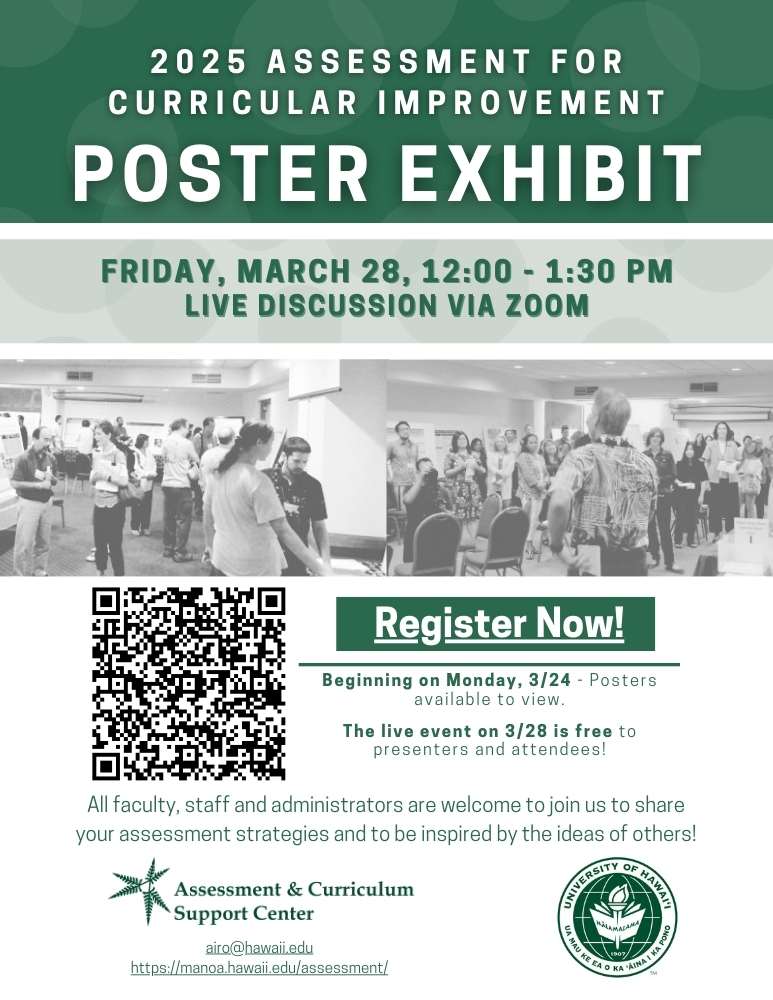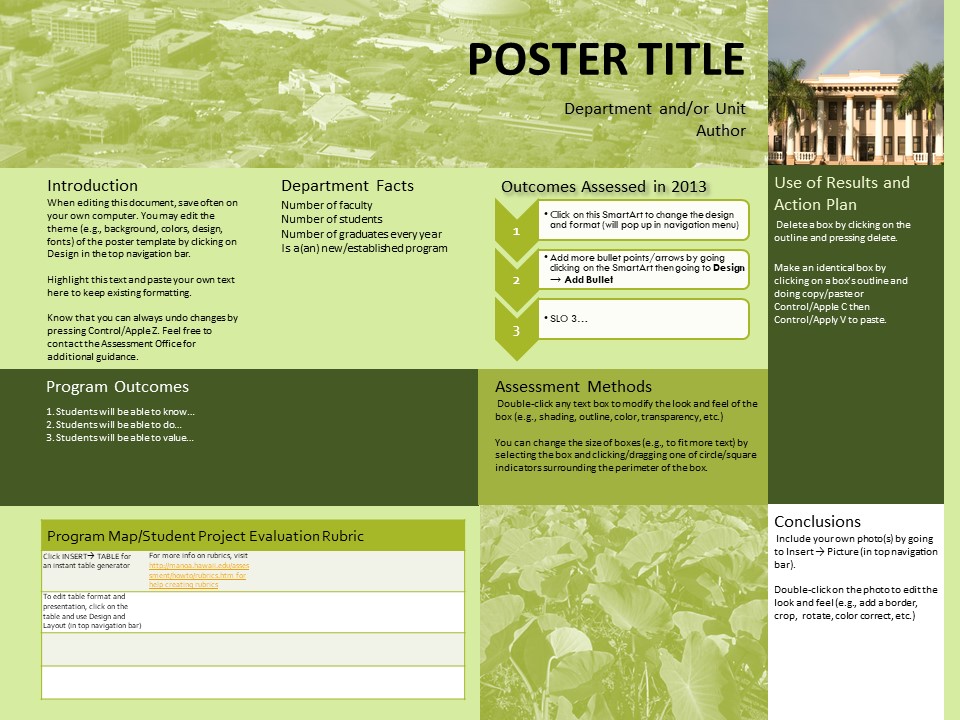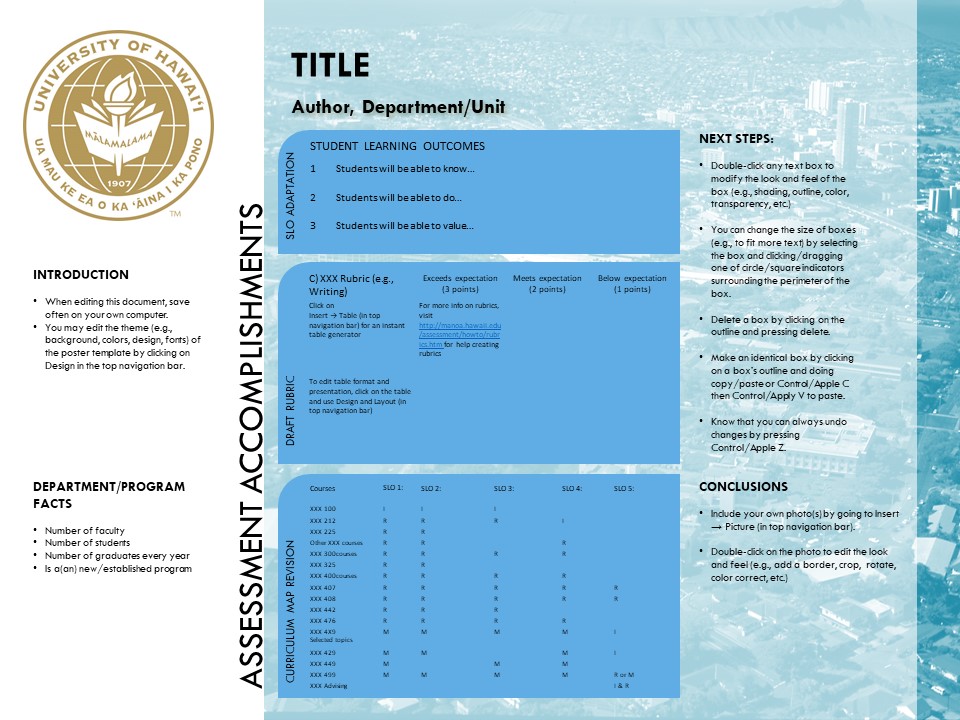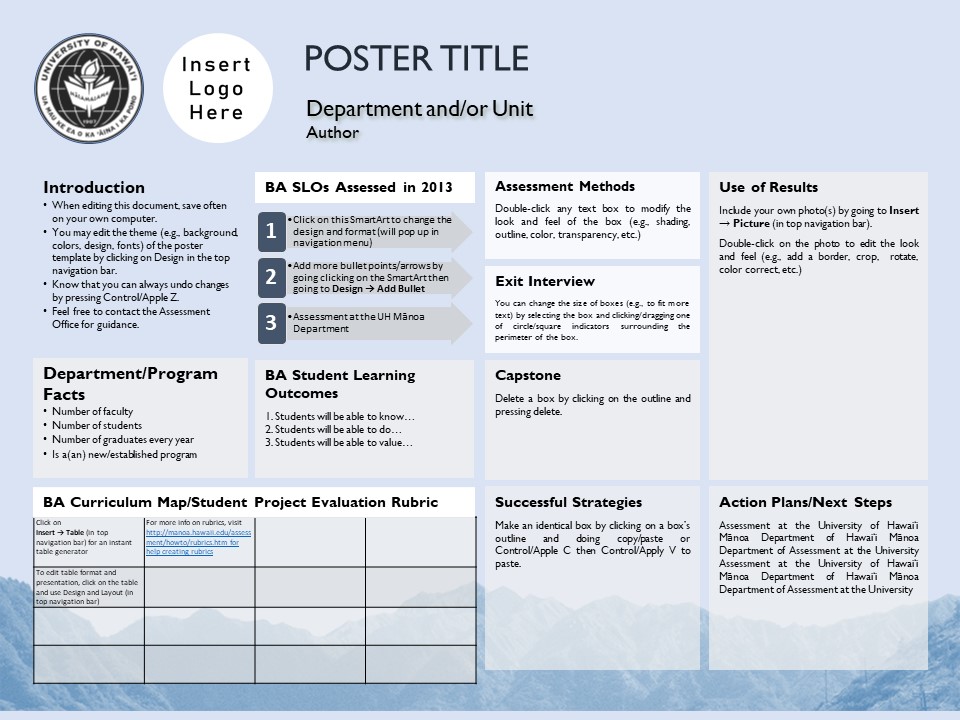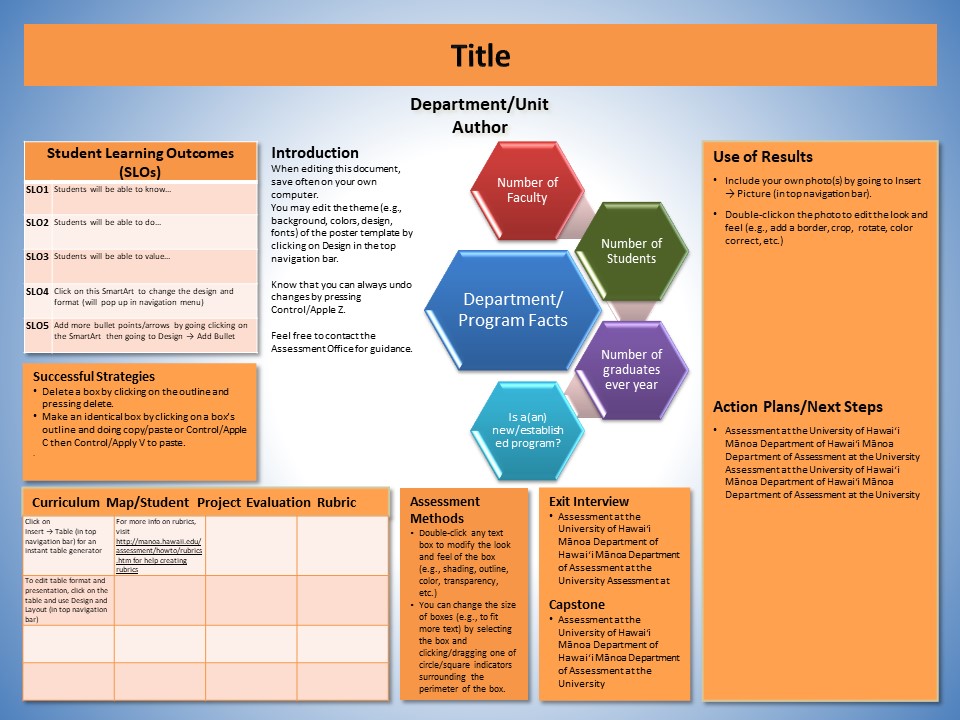Join us for the 11th annual Assessment for Curricular Improvement Poster Exhibit to share successful assessment strategies, gather ideas for curricular and co-curricular assessment, and network with colleagues.
Poster Exhibit Timeline
| Date (2025) | Description |
|---|---|
| Wednesday, February 19 | Deadline to Sign-Up to Present |
| Monday, March 24 | Asynchronous Viewing: Posters and poster presentation videos available to view online |
| Friday, March 28 | Live poster exhibit (via Zoom) 11:00-11:45 AM HST Presenter-only poster session to view peers’ work 12:00-1:30 PM HST Public event online via Zoom – live discussion with presenters |
Posters at the 2025 Exhibit
Aquino, Kamakanaokealoha M., Campos, Ruben, Hasager, Ulla, and Sabellano-Tsutsui, Tiare (College of Social Sciences, Hui ʻĀina Pilipili, ACCESS Engagement, University of Hawaiʻi at Mānoa): Developing Pilina: Introducing New Social Sciences Faculty to Kuleana
Blankenship, Chris (Learning Outcomes Assessment, Salt Lake Community College): (Re)creating Faculty Authority in Institutional Assessment
Dorado Wilson, Melanie, Kaun, Nalani, and Tupou, Noe (Academic Affairs, Division I, Planning, Research & Assessment, Hawaiian & Pacific Studies Program, Windward Community College): BOB: Build, Organize, Broaden
Dorsten, Aimee-Marie (Core Education, Point Park University): Untying a Gordian Knot: a Holistic Approach to Improving General Education Assessment
Jones, Nicole (College of Veterinary Medicine – Office of Academic Affairs, University of Georgia): The Development of a Comprehensive Course Review Process for a New DVM Curriculum
Ka’aiakamanu-Quibilan, Kenny and Peruma, Anthony (Information & Computer Sciences, University of Hawaiʻi at Mānoa): Developing Culturally-responsive and Equity-minded Assessment Practices in ICS
Kamanu, Alyssa (Earth Sciences, University of Hawaiʻi at Mānoa): Mapping the Earth Science Undergraduate Curriculum: Assessment of Student Learning Outcomes
Kelly, Jerae (College of Education – Special Education, University of Hawaiʻi at Mānoa): Lōkahi in Action: Faculty-Driven Change in Special Education Teacher Preparation
Okamura, ʻAlohilani, Simpson Steele, Jamie, McMullen, Jamie, and Kelly, Jerae (College of Education – School for Teacher Education, Special Education, Kinesiology and Rehabilitation Science, University of Hawaiʻi at Mānoa): E Hoʻoulu Kākou: Teacher Education and Professional Dispositions
Penaloza, Fiorella and Miranda, Jessica (Business Administration, University of Hawaiʻi at West O’ahu): Enhancing the Student Assessment Process: A Strategic Priority
Spencer, Lisa (Public Administration, University of Hawaiʻi at West O’ahu): Student Success Through Assessment
Umezawa, Kiyomi and Chun, Robyn (Curriculum Studies, University of Hawaiʻi at Mānoa): Evaluating Supports for MEd Early Childhood Education (ECED) Student Capstone Work: Moving Forward Together
Williamson, Cindy, Matthews, April, and Peters, Grace (Office of Accreditation and Assessment, University of Tennessee at Chattanooga): Implementing Requirement for Curriculum Maps as Part of Academic Program Assessment
Who attends the Poster Exhibit? Faculty, staff, and administrators interested in learning assessment for improvement.
Cost? No fee. Free to presenters and attendees.
All sign-ups to present are closed.
You may also view and download the text of the questions to prepare your answers by clicking the following link: Sign-Up Form Questions
Presenter Instructions and Help
Table of Contents
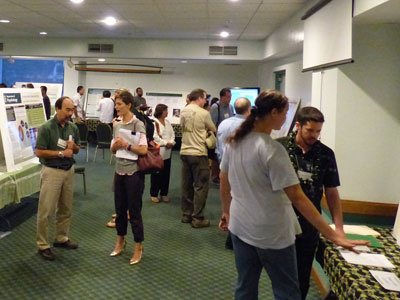
Presenter Instructions
- Complete the poster presentation sign-up form via Google Forms that is due approximately two months before the live poster session. Information needed:
- Contact information for presenter and co-presenters
- Poster title
- Poster abstract of 50-150 words
- Confirmation that you or a representative will attend the live Zoom discussion
- Consent or decline to have your poster published in UHM’s ScholarSpace repository.
- Help is available. See below for poster templates, tips, and assistance recording a video presentation. Or, feel free to contact us at airo@hawaii.edu for help with content, design, or technical issues.
- Submit a PDF version of your poster to airo@hawaii.edu two weeks before the live poster session.
- Optional: submit a 2-5 minute video recording of your presentation to airo@hawaii.edu two weeks before the live poster session.
- Engage with attendees at the live Zoom meeting (see above for day and time).
Templates
Please feel free to use the following letter-sized (11″ width x 8.5″ height) templates to create your virtual poster for online poster presentations (PowerPoint Slide/Google Slide).
Tips and Tools
- Strategies and Tutorials to Create Effective Posters and Presentations
- Suggested Poster Content
- Basic program information such as the number of faculty and students, degree(s) offered, and number of graduates per year
- Context of the assessment project: program learning assessment status/history of assessment in your program
- Description of the assessment project: useful tips, strategies, tools, steps in the process, end products, etc.
- Highlight how your program used assessment processes/findings for improvement
- Summary of accomplishments, lessons, strategies/tools to share
- Acknowledgements–assessment is a team sport
- Additional Content Considerations
- Have a clear theme and organization
- A program’s assessment efforts may include many accomplishments. Focus on a central theme/problem/project and organize the content to enhance the take-away message.
- Content is useful for audience
- Whenever possible, describe the processes, strategies, and tools that others may adapt/adopt. Attendees also appreciate knowing the challenges faced in the assessment project and (possible) solutions.
- Focus on assessment-for-improvement
- A primary goal of assessment is program and student learning improvement. Describe the action(s) that the program took in response to the assessment findings or challenges encountered (e.g., redesigning assignments, changing pre-requisites, refining advising practice, increasing faculty collaboration and collegiality).
- If possible, include the impact on student learning after the program took the action(s).
- Have a clear theme and organization
- Sample Topics and Past Presenters
- Use of assessment results for curricular improvement
- Curriculum mapping and its role in program assessment and improvement
- Development and use of a rubric for program assessment
- Capstone portfolio assessment for curricular improvement
- For more examples, see posters from the 2023 exhibit.
Evaluation Criteria
1. Poster Design Quality
| 4 | Exceptional. Exceptionally attractive in design, layout, and neatness. The design enhances the content and represents a clear flow of the content. The font size and typeface intentionally signal main and subordinate points/messages and are very easy to read. Graphics (if used) easily and quickly convey the meaning. |
| 3 | Proficient. Design, layout, and neatness help the viewer understand the content. The font size and typeface are appropriately sized for easy reading. Graphics (if used) convey the meaning, with the help of the text. |
| 2 | Developing. Design, layout, font are perfunctory and do not help or hinder the message. |
| 1 | Beginning. Design, layout, font hinder the message. For example, design is cluttered or illogical, layout is confusing, too much text, font size is too small to read. |
2. Use of Assessment for Improvement
| 4 | Exceptional. A group of faculty members (or other stakeholders) collaborated to use an assessment process or the assessment results directly and intentionally for the purpose of improvement (of student learning, the curriculum, resource allocation, policies, assessment processes themselves). They implemented the assessment process, engaged in critical reflection, and used the process and/or assessment results to logically inform changes. Bonus points to posters in which a follow-up assessment project was conducted to examine the effectiveness of the changes made. |
| 3 | Proficient. Assessment for improvement because the faculty (or other stakeholders) made changes that were informed by assessment processes and/or results. |
| 2 | Developing. The faculty (or other stakeholders) discussed possible actions but no clear action has been taken —OR— the faculty made changes but it’s not clear how the actions are tied to the assessment process/results. |
| 1 | Beginning. The project focuses on the assessment process or results itself without reflection/discussion/use of the process/results for improvement actions. |
3. Faculty Engagement Strategies
(a good assessment process is collaborative)
| 4 | Exceptional. The strategies to engage faculty (or other stakeholders) are really working. Faculty/stakeholders participate in assessment-related activities. They appear involved with an assessment-for-improvement process through their regular participation and ongoing attention to curriculum effectiveness and student learning at the program or institution level. |
| 3 | Proficient. Engagement strategies were used because faculty (or other stakeholders) did participate in at least one assessment-related activity aimed at the program/institution level. |
| 2 | Developing. The strategies appear to have engaged a few committed folks, but it’s unclear if participation is widespread and if faculty regularly attend to learning and curriculum development at the program/institution level as a result of the strategies. |
| 1 | Beginning. It seems to be a project primarily done by one person without participation/engagement from other faculty members. |
Best Practice Examples
For best practice examples, please also see the following 2024 poster exhibit award winners:
2024 Poster Awards
Best Faculty Engagement:
- K. ʻAlohilani HN Okamura (School for Teacher Education/Secondary Program, University of Hawaiʻi at Mānoa): E Ulu Aʻe
- Brett Oppegaard (School of Communication and Information, University of Hawaiʻi at Mānoa): Journalism Foundations
- Chanda Deaton & Julie Saam (Center for Teaching, Learning, and Assessment, Indiana University Kokomo): Remodel, Rebuild, Redesign: Rewriting our story for Co-curricular Assessment
- Kamakanaokealoha Aquino & Tiare Sabellano-Tsutsui (Hui ʻĀina Pilipili, Social Sciences Dean’s Office, University of Hawaii at Mānoa): Strengthen Ea Hawaiʻi within Social Science: An Assessment of Student Experiences
- Lorrie Wong (Nancy Atmospera-Walch School of Nursing/Nursing, University of Hawaii at Mānoa): Transforming Nursing Education – AACN Essentials 2021
Best Use of Assessment for Improvement:
- K. ʻAlohilani HN Okamura (School for Teacher Education/Secondary Program, University of Hawaiʻi at Mānoa): E Ulu Aʻe
- Brett Oppegaard (School of Communication and Information, University of Hawaiʻi at Mānoa): Journalism Foundations
- Kamakanaokealoha Aquino & Tiare Sabellano-Tsutsui (Hui ʻĀina Pilipili, Social Sciences Dean’s Office, University of Hawaii at Mānoa): Strengthen Ea Hawaiʻi within Social Science: An Assessment of Student Experiences
- Lorrie Wong (Nancy Atmospera-Walch School of Nursing/Nursing, University of Hawaii at Mānoa): Transforming Nursing Education – AACN Essentials 2021
Best Poster Design:
- Amy Fuller & Jill Denhardt (Chemistry, University of Hawaii at Mānoa): Kukui Nut Calorimetry, Place-Based Learning in General Chemistry Lab at the University of Hawaii at Manoa
- Kamakanaokealoha Aquino & Tiare Sabellano-Tsutsui (Hui ʻĀina Pilipili, Social Sciences Dean’s Office, University of Hawaii at Mānoa): Strengthen Ea Hawaiʻi within Social Science: An Assessment of Student Experiences
For additional examples, see all 2024 posters or view additional past posters in our archive by clicking here.

